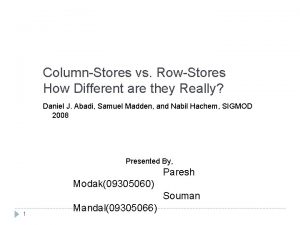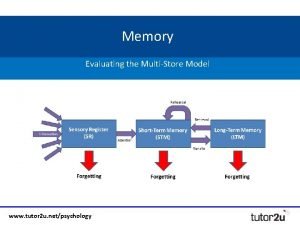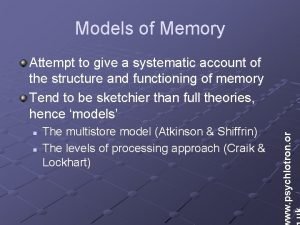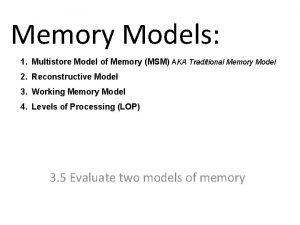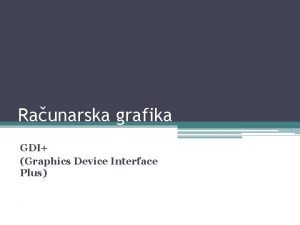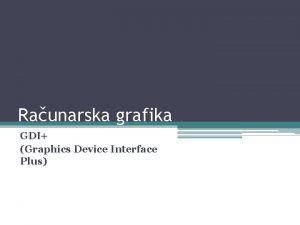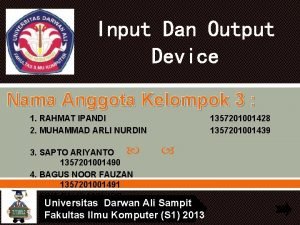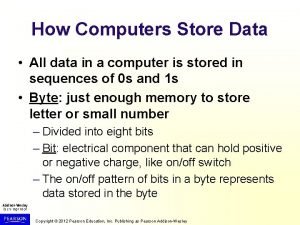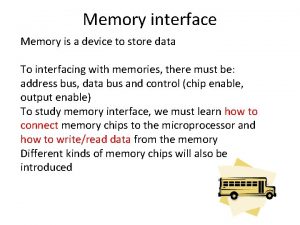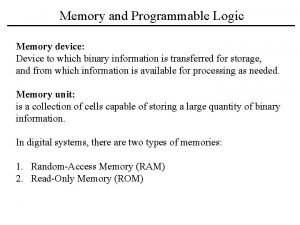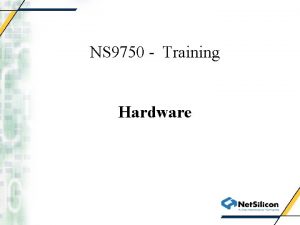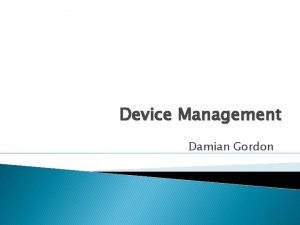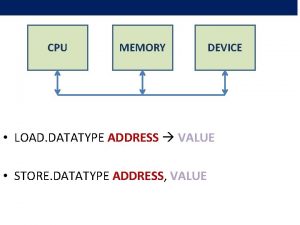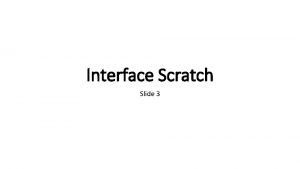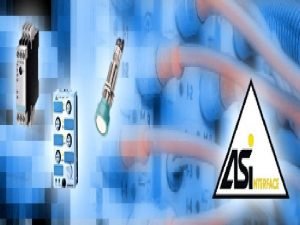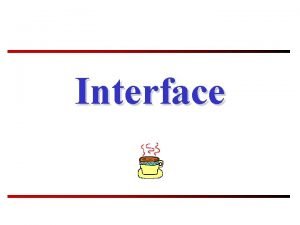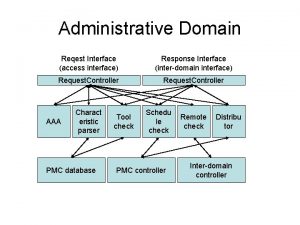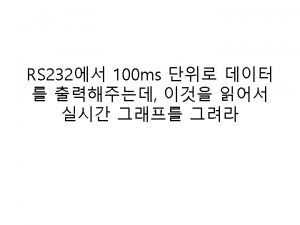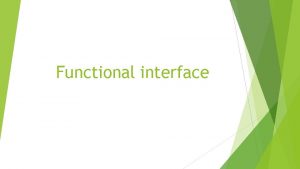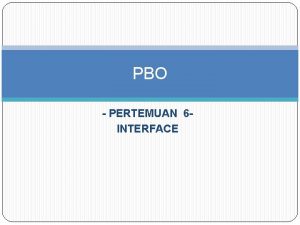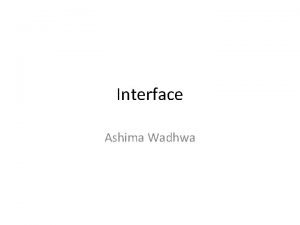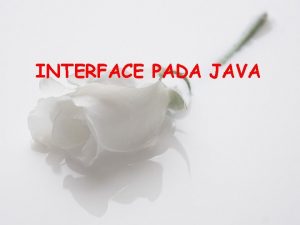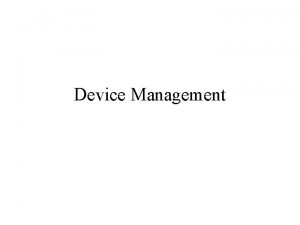Memory interface Memory is a device to store




































- Slides: 36

Memory interface Memory is a device to store data To interfacing with memories, there must be: address bus, data bus and control (chip enable, output enable) To study memory interface, we must learn how to connect memory chips to the microprocessor and how to write/read data from the memory Different kinds of memory chips will also be introduced

Memory • Knowing memory is becoming more important • Your mobile devices do not have a harddisk but they have memory • IPad or other tablet computer has no harddisk! – But still very powerful! • Latest trend SSD (solid state drive) – a data storage device that uses solid-state memory to store data similar to a traditional harddisk • SSD is now rather expensive – A 64 GB SSD is in the range HKD 1000

Block diagram of a memory interface Content Address in Hex FFFF Data Control signals Include enable (chip select) , read/write 0000

Self-test Memory capacity No. of address lines 128 K ? 16 M ? 14 M ?

Introduction • For the 8086 microprocessor, there are two modes: minimum and maximum • Under different modes, the memory interface is not the same • In the minimum mode, 8086 processor is connected to the external memory block directly • In the maximum mode, a Bus controller is needed • The bus controller will issue the required control signal to drive the memory block

Minimum Mode ALE /BHE /RD /WR M/IO DT//R 8086 /DEN A 16 -A 19 AD 0 -AD 15 memory

Address space and data organization • Memory is organized as 8 -bit bytes (byte as the basic unit) : one byte one address!!! • To address a word (16 -bit) then 2 consecutive bytes are used, lower addressed byte is the LSB (Least Significant Byte) and the higher-addressed byte is the MSB (Most Significant Byte) • Words of data can be stored at even, or odd address boundaries 16 -bit MSB LSB

Memory addressing • The address bit A 0 of the LSB can be used to determine the address boundary. If A 0 is 0 then we have an even address, or aligned • If A 0 is odd then we have odd-boundary • Example: 0001 H is an odd-boundary address

Example • A 0 = 1 example – A 16 -bit data store at 01 FFFH (then it is not aligned) and will occupy 01 FFFH and 02000 H (Odd boundary) • A 0 = 0 example – A 16 -bit data store at 02002 H (then it is aligned) and will occupy 02002 H and 02003 H (even boundary)

Question • If you are asked to implement the memory system for a 8086 microprocessor, what memory configuration will you use? A) One 1 M Bytes chip B) Two 512 KBytes chips C) One 1 M Word chip √

Address Space • Even-boundary word can be accessed in one bus cycle • Odd-boundary word must be accessed in two bus cycle • In 8086, user’s data usually is in 8 -bit or 16 bit format • For the system, instructions are always accessed as words (16 -bit) • There is also double word format (32 -bit)

Data type • Double word (32 -bit) will be stored in 4 consecutive locations • When double word is used? – Double word can be used as a pointer that is used to address data or code outside the current segment – For a double word, the higher WORD stores the segment address, the lower WORD stores the offset

Memory organization 1 M bytes memory using 2 512 K byte chips Odd boundary Address requires 2 cycles BHE – bank high enable

Hardware organization • In hardware, the 1 M bytes memory is implemented as two independent 512 K-byte banks • Low (even) bank, and the high (odd) bank • Data from low bank use data bus 0 -7 • Data from high bank use data bus 8 -15 • Signal A 0 enables the low bank • Signal /BHE enables the high bank • /BHE is active low • How many address lines are required in order to access 512 K locations? (Ans. 19)

Memory organization Only A 1 to A 19 are used to drive the memory !!! High bank Low bank

Odd boundary • Consider the 16 -bit word stored at 01233 H then it occupy 01233 H and 01234 H • 01233 H – 0000 0001 0010 0011 • 01234 H – 0000 0001 0010 0011 0100 • Only A 1 to A 19 are used to address the memory devices • Is it possible to active both addresses at the same time?

Odd-addressed word transfer Need two cycles! Odd address such as 1233 H (low byte) + 1234 H (high byte)

Example • Consider the 16 -bit word stored at 01 FFFH then it occupy 01 FFFH and 02000 H • In the first cycle data in 01 FFFH will be read • In the second cycle data in 02000 H will be read • Second case data stored in 02002 H then data occupy 02002 H and 02003 H. Compare the bit pattern for 02002 H and 02003 H • 02002 H – 0000 0010 • 02003 H – 0000 0010 0000 0011 • Once again only consider A 1 to A 19 • Why both byte can be read in a single cycle?

Memory organization If data is stored in address 0 H and 1 H then both bytes can be read in a single cycle because bit 0 is not used 000001 00000010 000001 High bank Low bank

Dedicated Memory locations Dedicated memory locations should not be used as general memory space for data and program storage For the 8086, address 00000 to 0007 F and FFFF 0 to FFFFB are dedicated Address from FFFFC to FFFFF are reserved

Exercise Determine the values for A 0 and /BHE in order to access A byte at even address (/A 0=0, /BHE = 1) A byte at odd address (/A 0=1, /BHE = 0) A word at even address (aligned) (/A 0=0, /BHE=0) A word at odd address (unaligned), as shown in the following figure (two cycles: First cycle get LSB /A 0=1 /BHE=0 Second cycle get MSB /A 0=0 /BHE =1 )

Memory control signals • To control the memory system in the minimum mode, requires: ALE, /BHE, M/IO, DT/R, /RD, /WR, and /DEN • ALE – address latch enable, signals external circuitry that a valid address is on the bus (0 ->1) so the address can be stored in the latch (or buffer) • M/IO – identify whether it is a memory or IO (Input/Output) operation (high – memory, low – I/O) • DT/R – transmit or receive (1 – transmit) • DEN – to enable the data bus

Read cycle of 8086 • Consists of 4 clock cycles • T 1 – memory address is on the address bus, /BHE is also output, ALE is enable • Address is latch to external device at the trailing edge of ALE • T 2 – M/IO and DT/R are set to 1 and 0 respectively. These signals remain their status during the cycle • Late in T 2 - /RD is switched to 0 and /DEN also set to 0

Read cycle • T 3 and T 4 – status bits S 3, S 4 are output • Data are read during T 3 • /RD and /DEN return to 1 at T 4

Read Cycle

Write cycle • T 1 – address and /BHE are output and latched with ALE pulse • M/IO is set to 1, DT/R is also set to 1 • T 2 - /WR set to 0 and data put on data bus • Data remain in the data bus until /WR returns to 1 • When /WR returns to 1 at T 4, data is written into memory

Write Cycle

Example • What is the duration of the bus cycle in the 8086 -based microcomputer if the clock is 8 MHz and two wait states are inserted Ans. 750 ns (6 cycles) where each clock is 125 ns

Demultiplexing the address/data bus • Address and data must be available at the same time when data are to be transferred over the bus • Address and data must be separated using external demultiplexing circuits (eg a latch, or buffer) • Address are latched into external circuits by ALE (address latch enable ) at T 1

Demultiplexing the system bus One direction Bi-direction STB - Strobe Latches/buffers

Syntax to describe a memory • Memory is usually described by its size of storage and number of data bits • Eg. A 32 K bytes memory chip is represented by 32 Kx 8 • A 32 K bits memory is represented by 32 Kx 1

Configurations of memory for 16 -bit data Chip enable (CE) usually generated by some decoding mechanism OE – output enable

Simple maths • From 00000 H to FFFFFH there are 1 M memory locations • How about from 0000 H to FFFFH? • How many locations between 1 FFFFFH to 310000 H (answer in terms of M + K and Byte) • A memory system has 4 M locations and the starting address is 420000 H what is the ending address?

Memory architecture

Memory architecture • Memory cells are usually organized in the form of an array • Each cell is capable of storing one bit of information. • Each row of cells constitutes a memory word, and all cells of a row are connected to a common line referred as the word line, controlled by the address decoder on the chip.

Memory architecture • The cells in each column are connected to a Sense/Write circuit by 2 bit lines, • The Sense/Write circuits are connected to the data input/output lines of the chip. • During a Read operation, these circuits sense, or read, the information stored in the cells selected by a word line and place this information on the output data lines. • During a Write operation, the Sense/Write circuits receive input data and store them in the cells of the selected word.
 Ram input or output device
Ram input or output device Row store vs column store
Row store vs column store Row store vs column store
Row store vs column store Abowd and beale framework example
Abowd and beale framework example Industrial interfaces
Industrial interfaces Interface------------ an interface *
Interface------------ an interface * What is interface in java
What is interface in java Strengths and weaknesses of multi store model
Strengths and weaknesses of multi store model Multi-store memory model
Multi-store memory model Oracle in memory column store
Oracle in memory column store Multistore model
Multistore model Somnoware device interface
Somnoware device interface Mobile robot navigation with human interface device
Mobile robot navigation with human interface device Pen color
Pen color Graphical device interface with c
Graphical device interface with c Kelompok input
Kelompok input A tagout device is preferable to using a lockout device.
A tagout device is preferable to using a lockout device. Nanocrystal flash memory device
Nanocrystal flash memory device Implicit memory
Implicit memory Logical versus physical address space
Logical versus physical address space Eidetic memory vs iconic memory
Eidetic memory vs iconic memory Long term memory vs short term memory
Long term memory vs short term memory Which memory is the actual working memory?
Which memory is the actual working memory? Shared vs distributed memory
Shared vs distributed memory Internal memory and external memory
Internal memory and external memory Virtual memory
Virtual memory Prototypes in semantics
Prototypes in semantics Primary memory and secondary memory
Primary memory and secondary memory Virtual memory in memory hierarchy consists of
Virtual memory in memory hierarchy consists of App on apple app store user
App on apple app store user How computers store data
How computers store data Dream pet store
Dream pet store Inc
Inc Urineluck store locator
Urineluck store locator Azure storage deduplication
Azure storage deduplication Back door delivery
Back door delivery Uwex learning store
Uwex learning store


